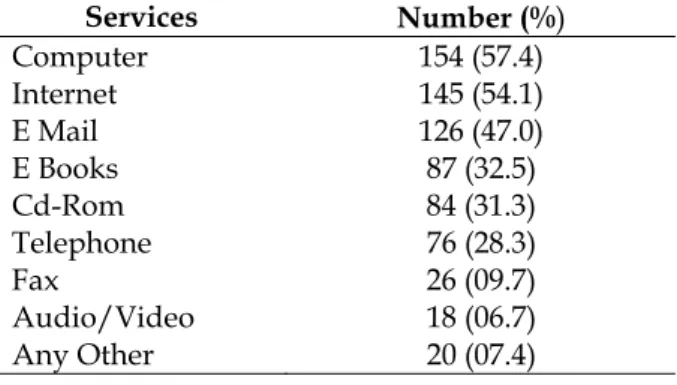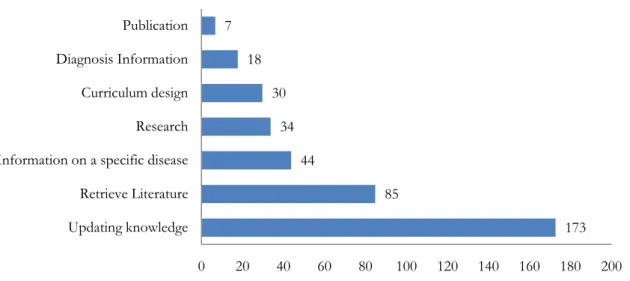.ORIGINAL ARTICLE.
A STUDY ABOUT LIBRARY USAGE BY
UNDERGRADUATE MEDICAL STUDENTS IN A MEDICAL
COLLEGE IN NORTH INDIA
N K Goel1, S S Sarpal2, Abhiruchi Galhotra3, Abhadeep4
1Professor, 2Post Graduate Trainee, 3Assistant Professor,4Lady Medical Officer, Deptt. Of Community
Medicine, Government Medical College and Hospital, Chandigarh
Correspondence:
Dr. Abhiruchi Galhotra
Assistant Professor, Dept. Of Community Medicine, Govt. Medical College and Hospital, Chandigarh
E-mail: abhiruchigalhotra@gmail.com, Phone: +91-9646121541
ABSTRACT
Background: Since no study has been done regarding use of library in medical students in North India and very few studies in whole of India that is why this study was conceived.
Objective: To study the use of library by medical students in all the professional courses in Government Medical College, Chandigarh U.T.
Material and Methods: 235 students were administered pre-structured and pre-tested proforma in classroom and guided filling of proforma was done by authors.
Results: Maximum students (265) were in the age group of 18-25 years.122 students felt that their objectives were partially fulfilled in the library, 71 felt their objectives were fully fulfilled in the library, while 20 felt none of their objectives were fulfilled in the library. 64.5 % students were visiting library for updating their knowledge, 31.7% for retrieving literature, 18.7% for information on a specific disease, 12.6% for research purposes, 6.7% for diagnosis, 2.6% for publications, 2.2% for patient care. Among the IT services available 57% were using computer, 54.1% were utilising internet, 47.01% were using E mail, 32.5% were using E books, 31.3%were using CD ROM, and 28.3% were using telephone. Out of benefits available of using IT services 75.7% said it lead to better access to information, 51.8% said it provided quick information, 42.9% said it lead to contact with distant personnel, 44.75% believed it lead to improvement in quality of work, 22.7%said it lead to decrease in use of postal mail, 10.8% said it lead to decrease in use of telephone, 10.1% said it lead to decrease in use of print version. 34.3 %( 91) students opined that there was need for an orientation programme regarding the use of IT services in the library.
Keywords: Library usage, undergraduate, medical college
INTRODUCTION
One of the major goals of medical education is to encourage students to maintain their knowledge of medical science by becoming life-long learners.1 Adequate skills in information seeking
and regular use of original scientific sources are key elements in this process. With regard to medical informatics education, both information processing and information technology have
been considered relevant for the quality of healthcare.2
well as the teachers, is an important means for enhancing knowledge and skills.3
The major purpose of the library is to provide
information.4 In addition to the traditional
function of collecting, organizing and providing access to information in print, modern libraries include online databases.5 Medical students may
not be able to learn all that they have to know only from formal classroom lectures. They also must learn to collect information by their own efforts, to develop adequate professional competence.6
Though an institution may have the best stocked libraries, the utilization of the libraries by the students need not simply depend on the number of books and journals in the library. Many factors like personal preferences, the general environment in the library, inconveniences of the working hours, distance from the place of residence, etc may influence the use of the libraries in order to meet the needs of the medical students.
This study was undertaken to determine usage pattern of the information resources and library services in the Government Medical College, Chandigarh, India. The feedback which is thus collected may help in formulating new policies and improving services and will also give information about what is expected as against what is available.
AIM
To study the use of library by medical students in all the professional courses at Government Medical College and Hospital, Chandigarh U.T.
OBJECTIVES
• To find out the extent of use of the library.
• To identify the utilization of IT services in
the library.
• To suggest ways to improve the resources in
the library
MATERIAL AND METHODS
A cross-sectional study was planned to be conducted amongst the students of various professionals at the Government medical College and Hospital, Chandigarh. A predesigned and a pretested questionnaire was used to collect data .The questionnaire consisted
of 27 questions. The questionnaire had following details –demographic data, utilisation pattern of library and IT services, fulfilment of objectives, personal opinion. The study was done from June 2005 to June 2011.
RESULTS
Maximum students (265) were in the age group of 18-25 years.
According to the professional year in M.B.B.S, 109 students belonged to first professional, 79 were from Second professional, and 80 were from Final Professional.
122 students felt that their objectives were partially fulfilled in the library, 71 felt their objectives were fully fulfilled in the library, while 20 felt none of their objectives were fulfilled in the library.
95.52% Students were not dependant on the library staff for search on internet. 41 students were fully satisfied with the IT services in the library,93 were partially satisfied,17 were not satisfied and 107 did not respond. 34.3 %( 91) students opined that there was need for an orientation programme regarding the use of IT services in the library
Table 1: Daily Library Use
Time Spent Daily in the Library
Number (%)
≤ 1 Hour 150 (56.6)
2-3 Hour 63 (23.8)
>3 Hour 16 (06.0)
Table 2: Frequency of library Usage
Frequency of Usage Number (%)
Daily 55 (20.5)
Once-Twice a week 117 (43.6)
Once in Fortnight-Month 26 (09.7)
Rarely 31 (11.5)
Never 39 (14.5)
Table 3: IT Services Usage Pattern in the Library
Services Number (%)
Computer 154 (57.4)
Internet 145 (54.1)
E Mail 126 (47.0)
E Books 87 (32.5)
Cd-Rom 84 (31.3)
Telephone 76 (28.3)
Fax 26 (09.7)
Audio/Video 18 (06.7)
Any Other 20 (07.4)
Table Number 4: Benefits taken by the students
Number (%)
Better access to information 203 (75.7)
Quick information 139 (51.8)
Improvement in quality of work 120 (44.7)
Contact with distance personnel 115 (42.9)
Decrease in use of postal mail 61 (22.7)
Decrease in use of telephone 29 (10.8)
Decrease in use of print version 27 (10.1)
Out of benefits available of using IT services 75.7% said it lead to better access to information, 51.8% said it provided quick information, 42.9%
said it lead to contact with distant personnel, 44.75% believed it lead to improvement in quality of work, 22.7%said it lead to decrease in use of postal mail, 10.8% said it lead to decrease in use of telephone, 10.1% said it lead to decrease in use of print version.
Figure No.1 shows the usage of library and its facilities by the students. 56.3% students were using both library and IT services, 26.1% were only using library and 2.9% were utilising IT services alone and 14.5% were not utilising any services.
Figure 1: Usage of library and its facilities
Figure 2: Frequency of usage of IT services by the students
Figure No.3 shows objectives of the students regarding the Library usage. 64.5 % students were visiting library for updating their knowledge, 31.7% for retrieving literature, 18.7%
for information on a specific disease, 12.6% for research purposes, 6.7% for diagnosis, 2.6% for publications, 2.2% for patient care.
Library 26%
IT 3%
Both 56% None
15%
Internet Browsing E Mail Medical Database CD Rom E Books
0 10 20 30 40 50
Figure 3: Objectives of students regarding Library usage
DISCUSSION
90.3% students visiting the library reported consulting textbooks according to our study A study conducted in north India7 showed that the
majority of students (82%) only consulted textbooks. The authors found there was a need to train and motivate undergraduates to make better use of library resources.
A similar study conducted in Kolkata3 found
that the majority of interns (62%) visited the library to prepare for examination. Other reasons for coming to the library were: seminars (14%); to consult manuscripts ⁄ dissertation ⁄
project reports (12%); and lack of personal books (10%).Amongst teachers, the majority (72%) came to the library to prepare lectures or for seminars; 42%came because they did not have their own books; and 39% were preparing manuscripts ⁄ dissertation⁄ project reports.
20.5% students were visiting library daily, 43.6% were visiting once a week, 9.7% were visiting fortnightly according to our study while study in Bhavnagar8 found 42% of respondents visited
the library daily, 15% went every other day 26% once a week, 3% fortnightly while in our study 20.5% visited the library daily, 43.6% went once a week and 9.7% every fortnight.
56.6% students were spending less than one hour in lib daily, 23.8% were spending two to three hours and 6% were spending more than three hours daily in library according to our study while 19% were spending less than one hour daily and 39% of the respondents were spending 2-4 hours daily in library according to study conducted at Bhavnagar. The primary
reason for visiting the library was for borrowing/reading books which are in line with findings of study carried out at Bhavnagar.
In usage of IT services 95.5 % respondents in the present study did not need the help of library staff. Internet Browsing and Email were most popular IT services availed by the respondents.
46% respondents expressed partial fulfilment of objectives in library while 26.7% students expressed complete fulfilment of their objectives in the library.
CONCLUSION
Majority of students prefer to read their own books in the library or to read text books. The role of well equipped medical library in order to meet the needs of medical students cannot be over emphasized. The effectiveness of a library as an instrument of learning is determined by the success with which it is able to provide the user the information he/she seeks. The library can fulfil its function best by pursuing a policy of constant self evaluation in order to meet be alert to the changing needs of its users.
REFERENCES
1. Romanov K, Aarnio M. A survey of the use of electronic scientific information resources among medical and dental students.BMC Medical Education 2006, 6:28
2. Haux R: Health and medical informatics education: Perspectives for the next decade. Int J Med Inf 1998, 50:7-19.
173 85
44 34 30 18 7
0 20 40 60 80 100 120 140 160 180 200
3. Chatterjee C, Joardar G, Bhattacharrya K, Nandy S, Misra R. Use of Medical Library by Medical Students and Teachers in Medical Colleges of Kolkata.Ind J Comm Med 2006,31(3):204-206.
4. Maliki A,Rachel D. Students Background Variables and the Utilization of Library Resources among Secondary School Students in the Southern Senatorial District of Cross River State, Nigeria. Stud. Tribes Tribals. 2007; 5(1): 21-23.
5. Geer RC. Broad issues to consider for library involvement in bioinformatics. J Med Libr Assoc. 2006; 94(3):286-98.
6. Rathnakara U,Shastry R,Unikrishanan B,Rao A. The utilization of library services by students in a medical college. Journal of Clinical and diagnostic Research.2011; 5(4):818-821.
7. Lal P,Ingle G.Use of medical library by undergraduate medical students in a medical college in north india.Indian J Comm Med 1999;24:86-88


